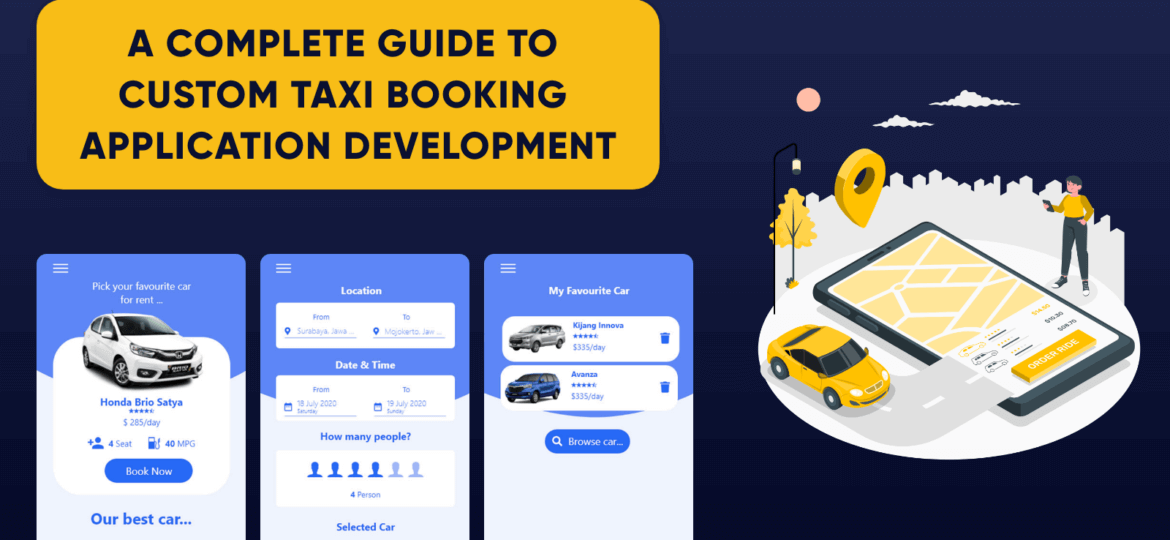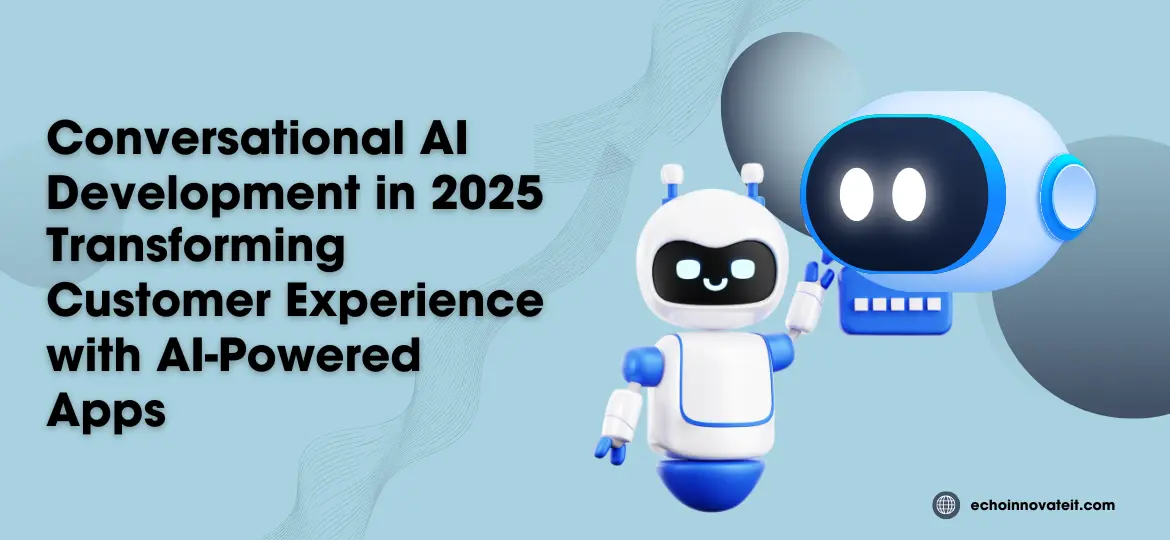Build a Scalable, Profitable Ride-Hailing App for Android and iOS
Developing a custom taxi booking app is not just a trend—it’s a necessity for mobility startups, transportation companies, and local fleet owners who want to compete in the fast-evolving digital transportation ecosystem. With the global ride-hailing market projected to exceed $400 billion by 2027, the U.S. market continues to lead in user adoption, particularly across mobile platforms like Android apps and iOS apps.
Why Launch a Custom Taxi App?
The demand for on-demand taxi booking services is skyrocketing in urban, suburban, and even rural U.S. regions, driven by smartphone penetration, digital payments, and AI-based convenience. A white-label or custom taxi app allows you to control branding, pricing, driver management, and monetization—creating a self-sufficient Uber-like business ecosystem.
In a saturated market dominated by Uber, Lyft, and Via, local startups and transportation companies still have room to grow by offering hyper-local solutions, competitive pricing, and improved customer experiences through mobile-first app development.
Key Features of a Successful Taxi Booking App
A taxi app must be more than functional—it must be intelligent, scalable, secure, and user-friendly across both Android and iOS platforms.
1. Real-Time GPS & Route Navigation
Live location tracking, optimized routes, and turn-by-turn navigation powered by Google Maps or Mapbox ensures drivers stay on track and passengers stay informed.
2. Smart Matching & Fare Estimation
AI-powered algorithms calculate ETA, route distance, and surge pricing in real time. In-app calculators help users understand fare breakdowns before booking.
3. In-App Payments & Digital Wallet Integration
Support multiple payment options: Apple Pay, Google Pay, credit cards, and third-party wallets for secure, seamless transactions.
4. Driver & Rider Profile Management
Verified user profiles, ID upload, rating systems, and behavior analytics ensure safety and trust between passengers and drivers.
5. Ride Scheduling & Multi-Stop Rides
Allow users to pre-book rides, add multiple stops, and choose vehicle types (economy, luxury, electric, wheelchair-accessible) for personalized service.
6. Admin Dashboard with Analytics
A robust web-based dashboard helps app owners track KPIs—active users, completed trips, driver availability, cancellation rates, and revenue.
7. Push Notifications & In-App Chat
Automated alerts for driver arrivals, trip status, promotions, and emergency messages enhance engagement and communication.
8. Driver Panel
An intuitive mobile dashboard for drivers to accept/reject rides, view history, and manage availability—all optimized for Android and iOS devices.
Development Process for Taxi Booking Apps
Building a high-performance taxi booking app involves careful planning, cutting-edge tech stacks, and responsive UX.
Step 1: Market Research & Feature Mapping
Analyze local competition, user pain points, and target market behavior to build a feature list tailored to U.S. user expectations.
Step 2: UI/UX Design
Use mobile-first principles with sleek navigation, large tap areas, night/dark modes, and ADA-compliant accessibility.
Step 3: Tech Stack
Frontend: React Native or Flutter for cross-platform
Backend: Node.js or Django with PostgreSQL/MongoDB
Maps API: Google Maps SDK, Mapbox
Payment: Stripe, Braintree, Square
Step 4: App Development
Build native or cross-platform Android and iOS apps for drivers, passengers, and the admin. Implement real-time communication with Firebase or Socket.IO.
Step 5: Testing & Deployment
Conduct multi-device testing, ensure App Store and Google Play compliance, and launch with a soft beta before full rollout.
Business Models for Monetization
Taxi app startups can earn revenue through multiple streams:
Commission-based model: Take a cut from every ride booked via the platform.
Subscription model: Offer premium services or tiered pricing for frequent riders or enterprise clients.
Ad revenue: Promote partner brands or local services within the app.
Franchise model: License your app to other cities or countries under your brand.
Advanced Technologies in Taxi Apps
To stay ahead, your app should support:
AI for demand forecasting & driver allocation
Machine Learning for fraud detection
Blockchain for ride verification & payment transparency
EV fleet optimization & carbon tracking
AR-based indoor pickup navigation
Trends in Taxi App Development
Rise of EV & hybrid vehicle integration
Cross-platform apps (Flutter/React Native) dominate for cost-efficiency
Voice-controlled booking for hands-free mobility
AI chatbots handling 24/7 support inside apps
Eco-conscious trip options with carbon tracking
What Is The Future Of The Online Taxi Booking Industry?
Taxi booking app development is a type of business that offers advantages like money and time by creating mobile applications.
With taxi applications, you may simultaneously interact with two primary interfaces, passengers and taxi drivers, which are visible to you in the same phase.
Asian, American, and European nations increasingly depend on taxi booking app development because of the increase in steady income.
Additionally, due to the increase in smartphone use in emerging nations like Vietnam, Malaysia, China, India, and other countries, consumers are increasingly turning to ride-sharing services rather than traditional taxi services for transportation.
Due to this strategy, many taxi firms have been encouraged to extend their operations via mobile apps.
The ease with which online taxi reservations may be made and traffic congestion are the primary reasons for developing the online taxi industry and a taxi booking app like Uber.
Online Taxi Booking Business Model
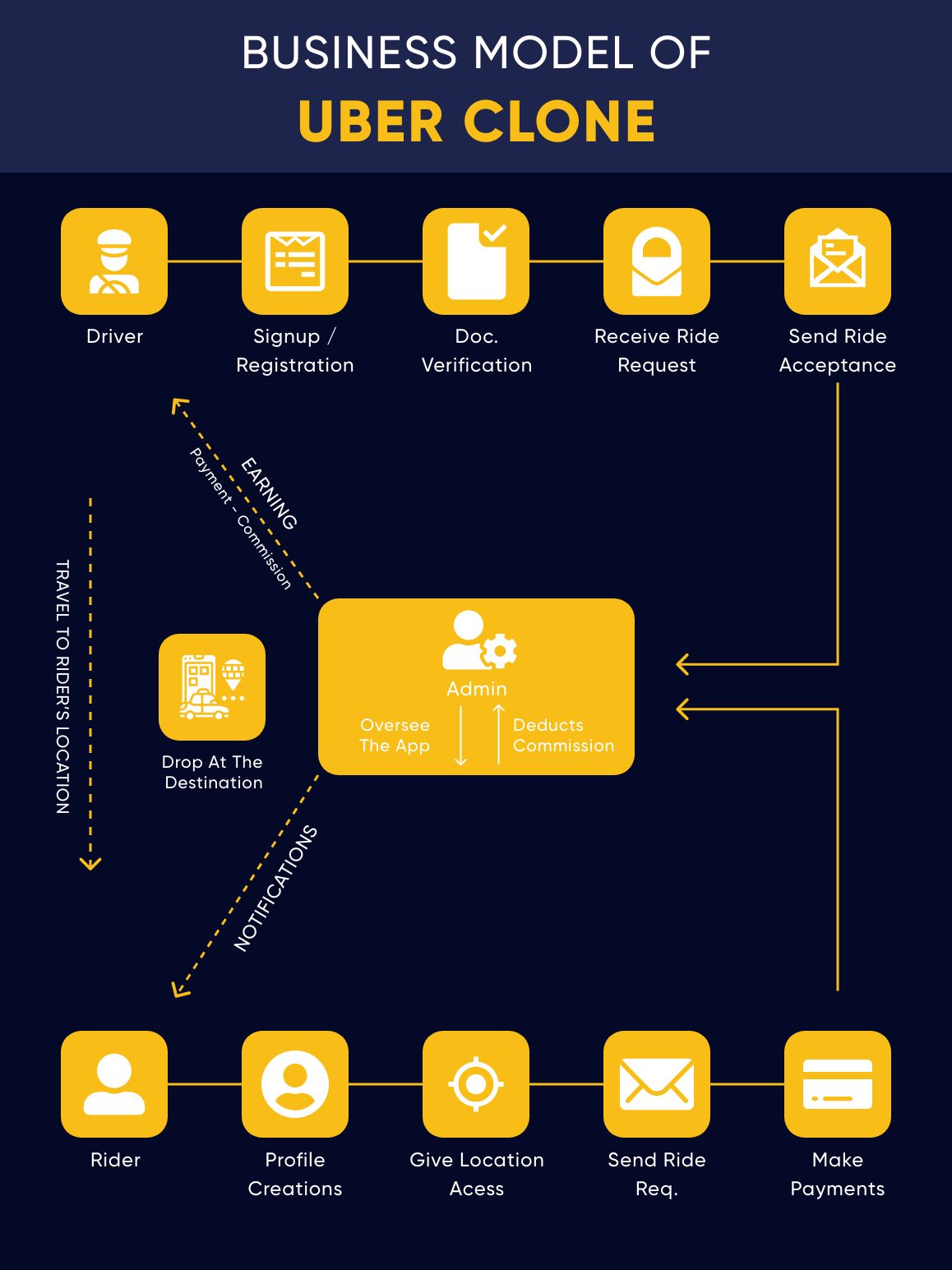
How Does An Online Taxi Booking App Work?
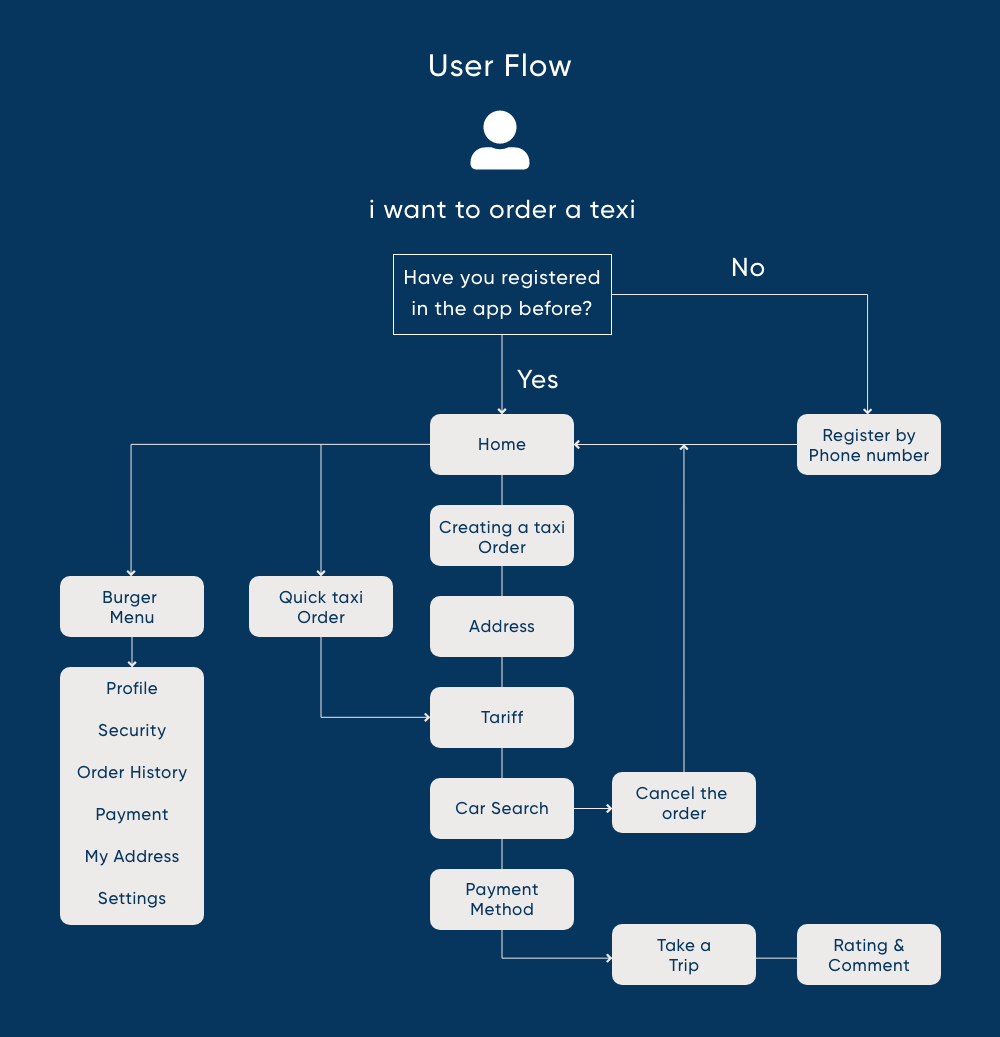
In this era of digitization, the Uber app has become one of the most popular apps with its distinctive business model. It is a two-sided marketplace platform following an aggregator model. Let’s look at the following steps to explain the workflow of an online taxing booking app such as Uber.
Install & Sign Up Login
In this era of digitization, the Uber app has become one of the most popular apps with its distinctive business model. It is a two-sided marketplace platform following an aggregator model. Let’s look at the following steps to explain the workflow of an online taxing booking app such as Uber.
Choose Location & Book a Taxi
Once the initial setup is completed and location access is given, they can send ride requests by specifying the pick-up and drop locations.
Taxi Booking Confirmation
The app will send the ride requests initiated by the passengers to the drivers. If a driver accepts the request, the booking confirmation will be sent to the rider. If the driver rejects the request, it will be passed on to the nearby driver.
Taxi Tracking Map & Access
After the ride confirmation, the driver will reach the pickup point with the help of a taxi tracking map, and riders will take their rides. The riders can check the way to ensure the drivers are riding to the correct destination point.
Payment Transaction
After reaching the destination, the riders can make either cash or digital payments. You can allow cashless payments to make transactions simpler and easier.
Driver Feedback & Review
To gain trust among the passengers, you can encourage them to leave their opinions regarding the service you are offering. It includes collecting reviews or ratings about the behavior of drivers.
Revenue Sources From Online Taxi Booking App Business
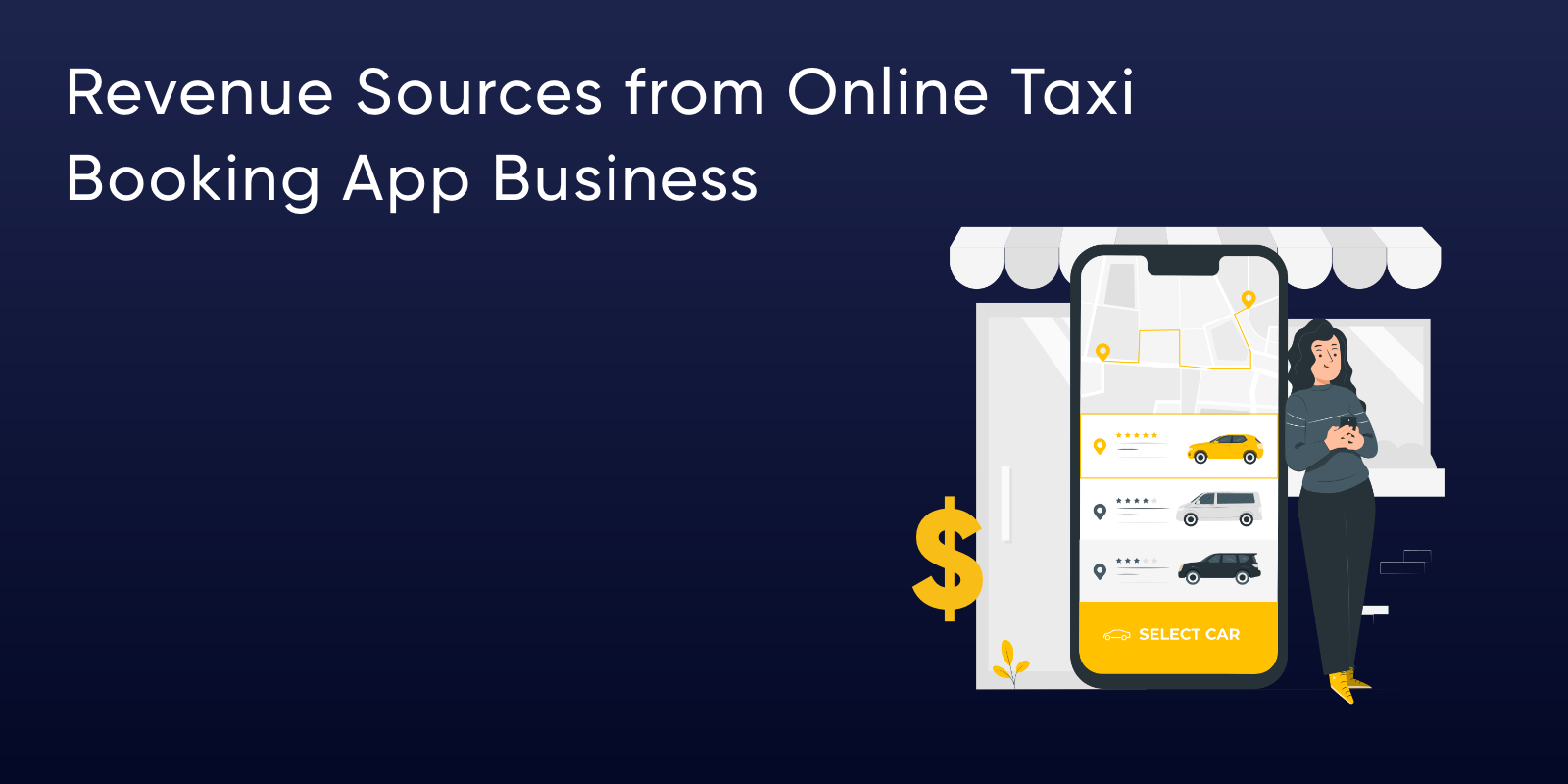
Commission Charges
An owner can set an amount he wants to charge as a commission for every ride. Therefore, the driver has to pay a fixed amount after he starts working on your platform.
Cancellation/Waiting Fees
Cancellation fees are another great way of generating revenue from customers. There is a decided period in which a customer can cancel a ride. If a customer takes longer than that, he must pay a cancellation fee on the next trip.
Surge Pricing
Surge pricing has been a very controversial feature so far. However, you must integrate this feature in your taxing booking application as it changes the fare dynamically by analyzing various factors such as weather, local events, traffic, and demand.
Premium Charges
The owner can also charge a subscription fee to the customers, for which you can offer them access to advanced and premium features.
Interested customers can pay the subscription charges to enjoy the perks of premium features.
In-app Advertising Charges
You can easily advertise your Uber business model through various channels if you think the promotional method would be costly.
You can also do in-app advertisements and display ads on your app.
How To Develop A Taxi Booking App?
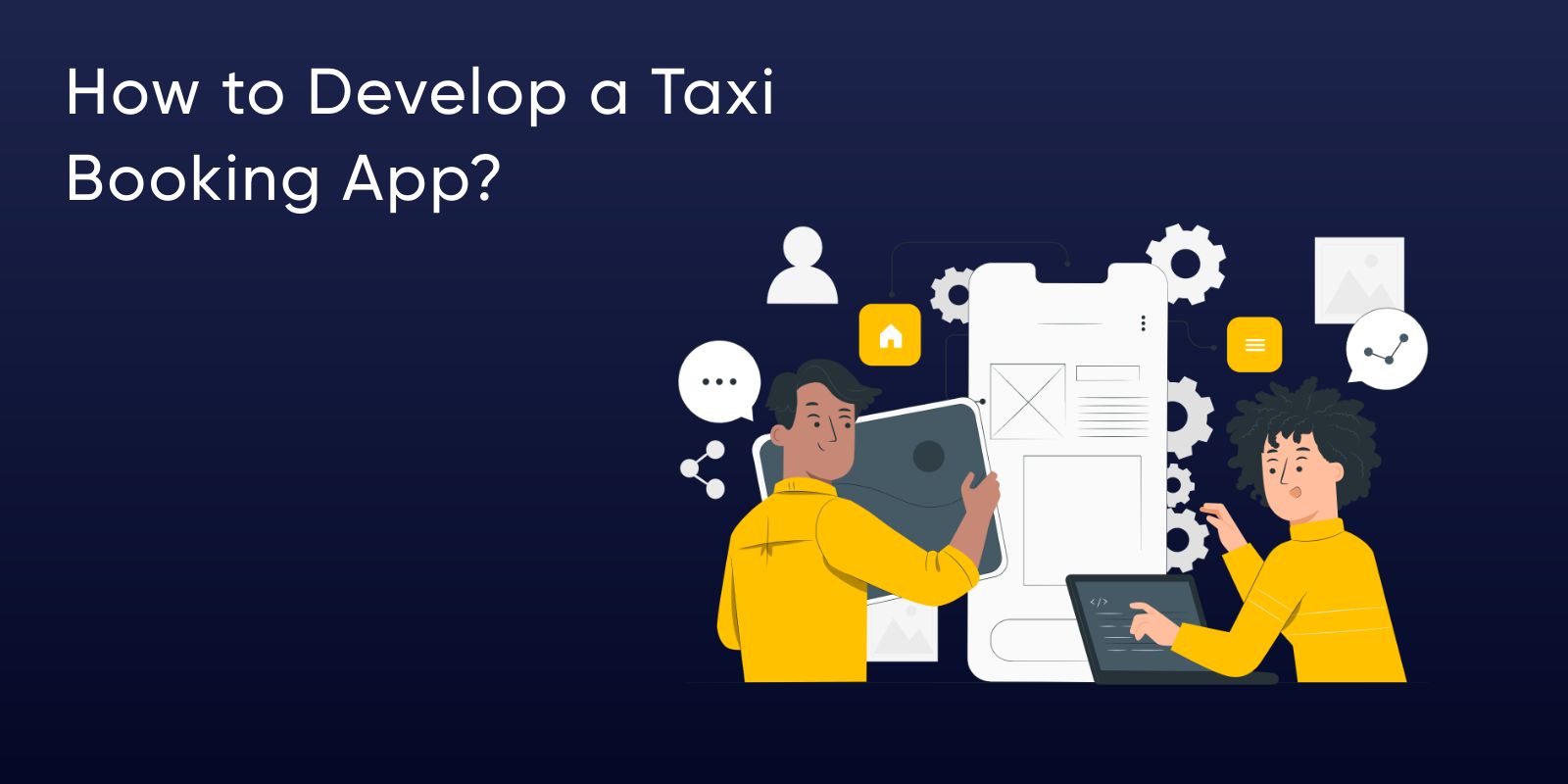
Let’s discuss the development process of the taxi booking application step by step:
Step 1 – Learn The Market
Learning about the market in which you are about to step is essential.
First of all, you need to select a location for your app within a city or country, and then later, you can plan to expand it globally.
You must also select the best payment system for your country.
Choosing an appropriate payment system is also important because countries have different and famous payment systems.
These factors greatly influence the complexity of the final product and testing process.
Step 2 – Develop A Business Model
This is a very important step in the development process of the taxi booking app.
At this step, you decide whether you will be a company that hires drivers and pays their salary or wants an Uber-like business.
The selection of monetization ways greatly affects the complete development process. You can design an app that will take money from drivers they get from rides as the common taxi orders base.
Therefore, passengers pay the drivers directly, and you get a fee.
Step 3 – Technical Specification & Requirements
This step of the taxi booking app development process includes creating a detailed technical specification with a list of requirements.
It gives complete clarity about the architecture and functionalities of the application that is to be developed.
This step can be handled by a team or by an outsourcing company.
They use technical language to help stakeholders easily understand what you will build.
The technical specification helps you with cost estimation as well.
Step 4 – Choose the Best Development Model
Choosing the best development model for your app is another important step in development.
The development model helps you determine the cost and time required to build the application. You should clearly understand what team members you need to complete the development process.
The app development process usually includes developers, UX UI designers, and the QA team.
If you choose to create a team by yourself, it is very expensive. You should simply hire an entire team or a company that is available at a low cost and guarantees a higher success rate.
Step 5 – UX/UI Design
Once you have selected the development team for your taxi booking application, the UX UI design team handles the next step.
This is to be done before the development.
Designers will give you different prototypes, including wireframes and mock-ups, to help you visualize their final application. Hence, at this step, you need to discuss your needs and plans for the app design with your UX UI team.
Step 6 – Backend Development
The backend development step is done to integrate the mobile app’s functionalities with the database.
During this stage, developers package your application with the server and middleware. Your development team also selects a team that works with Java, Python, Go, or Swift.
These are the most prominent languages used to create the application’s backend and depend on the platform your platform will work for.
Step 7 – Testing by the QA team
Once you have completed all the steps, you can deliver your app to the QA team for complex testing. Quality analysts check the final product’s functionality, efficiency, usability, and effectiveness.
Step 8 – Launch
After being successfully tested and verified by the QA team regarding all vital requirements for your application and the user experience it provides, your taxi booking app is finally ready to launch. The application should be agreed upon by the store you choose, as some problems may occur at this stage, too. This is why it is always easier to ask a third-party app to take care of distribution on platforms like App Store or Google Play.
Features Of Taxi Booking App Development

You have to design two apps, one for customers or passengers and the other for the driver, when you develop a taxi booking app. Also, an admin panel must be designed so the cab rental owner can manage all the taxi booking operations. Let’s have a closer look at the must-have features:
Enter Drop Location
Entering the drop location is an essential feature so that the cab booking app will know the passenger’s destination; with your ‘where to’ location, the taxi booking app will show you your next ride’s estimated time and cost.
Once you enter the correct ‘where to’ location, the app will ask you to confirm the ride to find the nearest driver, and the drop location is later followed by the live GPS tracking in-app feature for both the driver and the passenger.
Schedule a Ride
Scheduling a ride is one of the essential features of any taxi booking app. It enables the passenger to book their rides well in advance, which makes them feel more secure about their cab timings. It also allows you to manage your time for the next meeting.
Choose Vehicle/Ride Type
Another important feature should be integrated with a taxi booking app. The choose a vehicle and select ride type’ feature enables the passenger to choose their car at their convenience.
For example, Uber provides a ride type from which to choose. The premium ride type has a luxurious car and a good interior compared to the Uber Go ride type.
Similarly, Ola enables passengers to choose from the available list of vehicles as per their requirements.
Confirm/Cancel Ride
The next essential feature is integrating the ‘Confirm and Cancel ride’ feature into a taxi book app. After selecting the drop location, the passenger must confirm the ride by clicking the confirm ride button.
And, if there are any changes in their plans, they can cancel the ride by giving a suitable reason. Uber charges a fixed fee for canceling the ride after a particular time.
Live GPS Tracking
The ‘Live GPS tracking’ feature helps the driver reach the correct location.
In-app map integration tracks the drop location, enabling the passenger and driver to check the map and follow it to reach their destination by taking the safest route.
It is one of the great route tracking and guiding features you should integrate into your taxi booking app.
Share a Review
This is a very important feature to check the performance of your application. Reviews and ratings are great ways to help the driver get their deserved rating and feedback from the passengers. The same goes for the passengers. There is a whole history of ride-sharing that lets the drivers and the customers know each other via in-app ratings and feedback.
Advanced Features Taxi Booking App
The advanced features for taxi booking apps that you can add to your application to travel that extra mile of perfection.
Book Now, Ride Later
This feature lets you arrive on time for important events and appointments. Also, it allows you to book your rides 30 days prior. With this feature, the passengers can attend their functions, interviews, and meetings on time. Adding this advanced feature to your taxi booking application can attract more users.
Mobile Wallet
A mobile wallet is an amazing feature that gives a big relief when paying after a ride. You are saved with struggles like having no change or adding credit/debit card details every time after a ride. Uber supports mobile wallets, in which you need to add funds once, and then your ride charges are deducted after each ride, so you can have a hassle-free ride without worrying about paying after the ride.
Panic Button
In any emergency or situation of distress, there is a panic button that acts as a savior and should be on the list of advanced features for taxi booking apps to assure your users about their safety from our side.
This button works as follows: a help button leads us to the SOS or emergency window, which shows the option to call the police or withdraw the emergency drill.
Promo codes & Referral Rewards
This feature is inevitable in the advanced features of taxi booking apps as it can become a source for retaining more customers. You can offer additional services by adding a site credit for referring to new users and dias asndiscountsmo codes for getting a reward.
Favorite Location
Users can add their favorite location to visit there and avoid entering details every time. This lets the passenger quickly book rides when they are getting late.
Split Fare
This is one of the best features to integrate into your taxi booking app, as it helps you to select fellow riders by adding contacts from your phone. Then, the fare will be split based on their drop-off location or equally distributed among the riders.
Book for others
This will be very convenient for users as they can book rides for their loved ones. Uber has integrated this feature into their app, and all you have to do is book a cab, add a contact number, pick up location, and drop off location, and you are good to go.
Tipping Option
This feature enables drivers to accept tips from the riders through the app, and you can pay the desired amount. This feature can hold more and more drivers to be engaged with the application.
24 hours phone support
This feature becomes necessary for any application to ensure the user trusts your services. They need assurance before opting for any service and maintain that you can add this feature to your taxi booking app to solve their problems anytime.
Destination Filters
This is one of the most interesting features as it enables users to enter their destinations so only those rides are matched for those drives. This makes it convenient for drivers to accept rides at their convenience.
Earnings for long pick-up time/wait times
This feature can be integrated to deal with problems such as long pick-up times or cancellations amidst long pick-ups. Adding such a feature can tackle such issues and enable the driver to earn more.
5 Best Examples Of Taxi Booking Apps
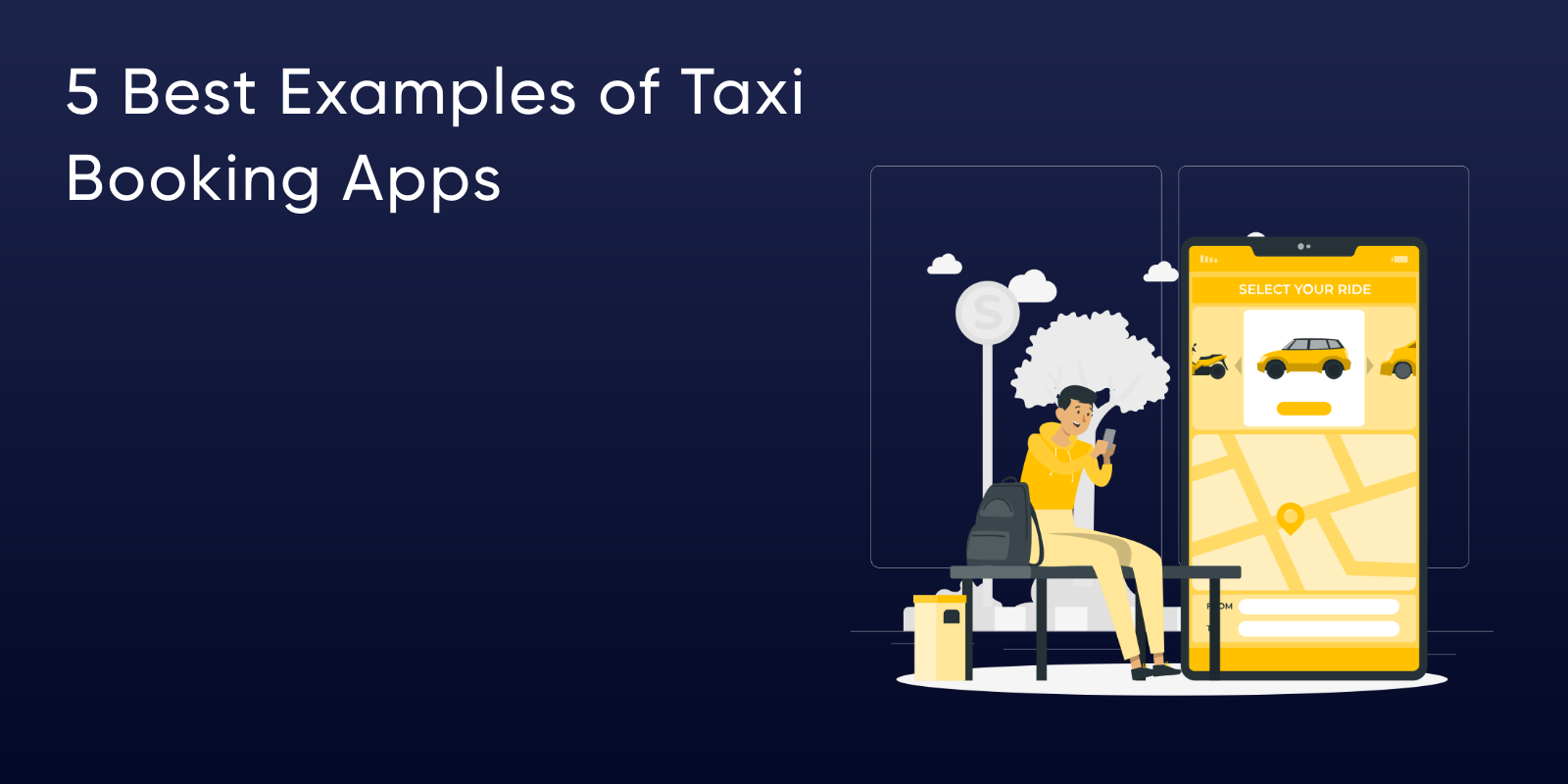
Let’s have a look at the best taxi booking apps and their unique features.
Uber
This was launched back in 2009 by Garrett Camp. Uber is available in around 630 cities and continues to expand to new locations. 2019 Uber purchased Careem, a taxi booking app operating in the Middle East, for $3.1 billion.
Uber’s service has a range of categories that suit every user’s requirements and budget. These include UberPool, UberX, UberGo, UberBlack, and more. Uber has evolved a lot in the past few years.
Uber Technologies has raised more than $22 billion in funds for its taxi booking app development.
Lyft
The Lyft app was launched in 2012. Earlier, it operated under Zimride, a ridesharing service connecting drivers and passengers via Facebook for long distances.
The Lyft taxi booking app is considered a competitor of Uber and is present in 200+ cities in the US market. The unique feature of Lyft is its rating system, which only keeps drivers with the best ratings.
Also, Lyft’s taxi application has liability insurance of $1 million. Apart from that, Lyft is considered cheaper than Uber; you can expect to pay around $12 compared to $16.
Gett
Gett taxi booking app operates in 100+ cities in the US and Europe. The benefits of the Gett app are the ability to book your ride two weeks in advance and the provision of 24*7 passenger support.
The Gett app does not have surge pricing and only charges a 10% commission fee for each ride. It is known that Volkswagen Group invested $300 million in launching the service in the European market.
Lecab
LeCab is a private transportation service offering cab services with flexible booking options via a mobile app and the web. Today, LeCab has more than 1 million users, 7,000 corporate clients, and more than 13,000 drivers, and it is present in 24 cities in France. They offer the best experience on the market with the top drivers at the best price.
Grab
Mobile app and the web. Today, LeCab has more than 1 million users, 7,000 corporate clients, and more than 13,000 drivers, and it is present in 24 cities in France. They offer the best experience on the market with the top drivers at the best price.
This taxi mobile app provides many ride options and payment possibilities (a card, cash, Grab credits).
The passenger can choose GrabTaxi, GrabShare, GrabHitch, GrabBike, or GrabFamily as their mobility service. On average, the user can expect to pay $5 per ride.
Technology Stacks For Taxi Booking App
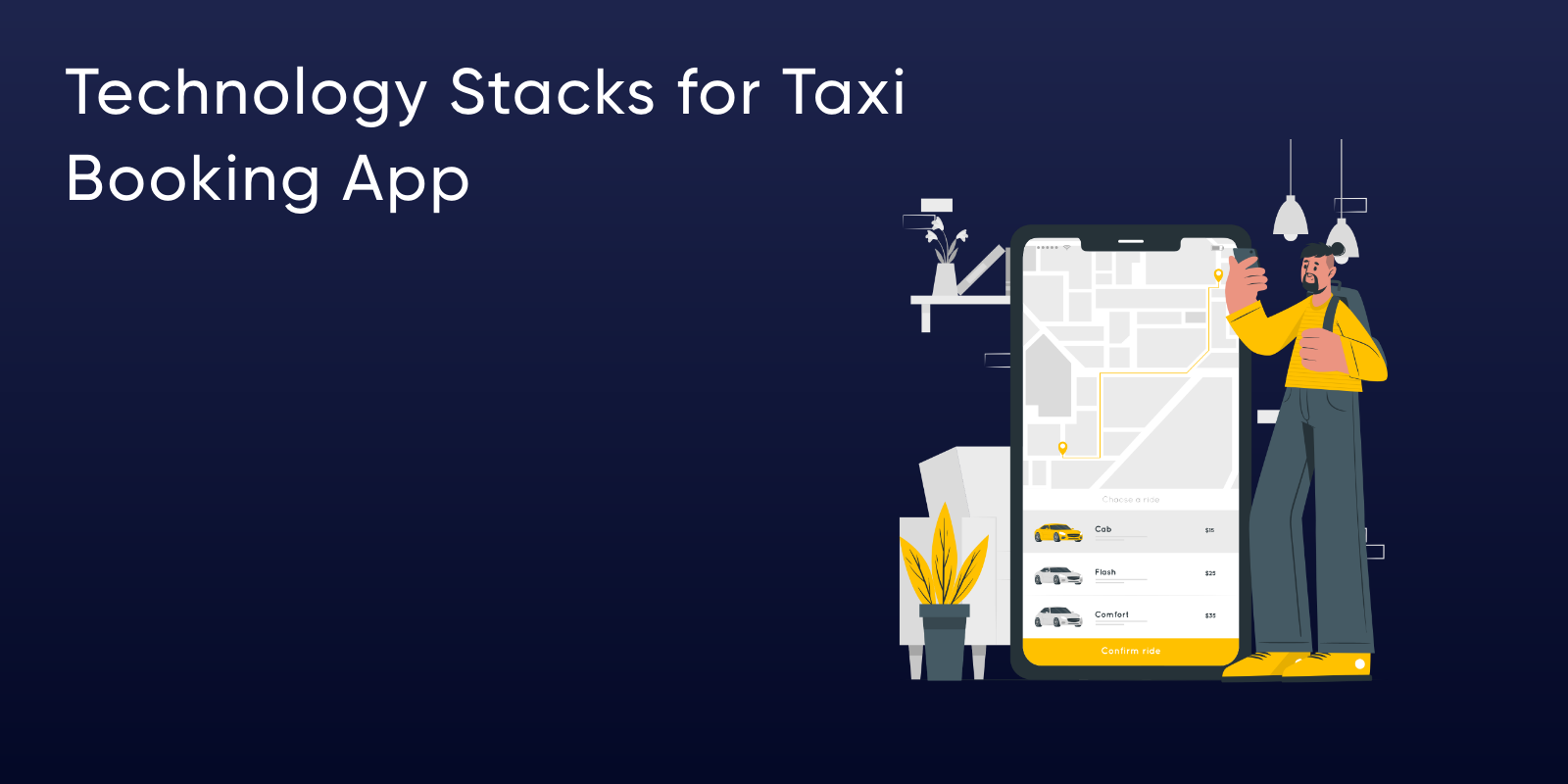
The passenger can choose GrabTaxi, GrabShare, GrabHitch, GrabBike, or GrabFamily as their mobility service. On average, the user can expect to pay $5 per ride.
- The Backend
- App Development for Android/IOS
- App Design
Backend of a Taxi Booking Mobile App
The backend is the backbone of an application. A backbone is responsible for the functions of an application and binds them with their respective output. This is the first and foremost stage in the taxi booking app development process. JavaScript and Python are the most popular languages for linking the app to the right interface. Afterward, you must select a database to securely store the app’s data. MySql, PostgreSQL, SQL Server, and Redis are the most widely used. Backend development can be time-consuming and usually requires a lot of resources.
Taxi Booking App Development for iOS/Android Platforms
Most of the time, businesses planning to develop a mobile app get confused while selecting the right development platform.
Android and iOS are the most dominant platforms, so the choice comes down to these fabulous options. Businesses can develop apps for both platforms to avoid the dilemma, and this way, they won’t miss out on either user base.
The backend interface for both apps is the same. Only the tools used in the development and the choice of framework are different.
Android App
- Build System
- Networking
- Image Loading
- Automation Coding
- Background Services
- Maps
- Gradle
- OkHttp, Volley, Retrofit, and Gson
- Glide
- Espresso
- Services
- Google Maps
iOS App
- Repository
- Placement and Sizing
- Crash Detection
- Testing
- Storage
- Backend
- Vivo Cab Rider/Vivo Cab Driver (Github)
- UI image extensions/IQ keyboard manager
- Fabric
- Xcode instruments
- Local Preferences/Core Data
- Almoner/Moya/Google Services
App Designing
The success of your application also depends on its design. It mainly consists of graphics design, user interface, and user experience design, followed by some SEO guidelines.
A whole host of design tools, such as DreamWeaver, Photoshop, and Panic Coda, can be used to design the layout of your app.
Factors Affecting Cost To Develop A Taxi Booking App Like Uber
Apart from features, various factors are responsible for deciding the overall cost of developing an app like Uber. Let’s have a closer look at them:
Company Type
Your company type is a significant facet. Are you a startup? Do you wish to build the app alongside your business? Startups may face a tight budget scenario compared to a well-established company.
App Platform
Your company type is a significant facet. Are you a startup? Do you wish to build the app alongside your business? Startups may face a tight budget scenario compared to a well-established company.
Type of the App
Another important decision to make here is the technology front. You may choose to develop a native app that’s somehow more reasonable than a hybrid one.
You can consult an expert mobile app development service provider if unsure. Experts can simplify your work and help you make the right decisions.
Tech Stack for Uber App & Development Team
The app development company you hire will use different programming depending on your needs. For developing an app like Uber, the tech team should have expertise in the following programming languages or tools:
- Twilio
- Kotlin for Android app
- Node.js for back-end
- PayPal / Stripe
- Facebook SDK
- APNS
- Google Places
- Card.io
- Elastic email
- Amazon EC2
- Amazon S3
- Google Maps
- Google Directions
- Firebase
- Socket.io
And your app development team must include the following experts:
- Project Manager
- Business Analyst
- Android / iOS engineer
- UI/UX designer
- Back-end developer
- APNSQA engineer
The total cost of app development may vary depending on the size of the team and their experience.
How much does it cost to build an app like Uber?
Apart from features, various factors are responsible for deciding the overall cost of developing an app like Uber. Let’s have a closer look at them:
| Feature | Approximate Time | Approximate Cost |
| Payment Integration | 3 to 6 weeks | $6,000+ |
| Geolocation features | 3 to 6 weeks | $6,000+ |
| Ride scheduling | 3 to 6 weeks | $6,000+ |
| Booking a ride for others | 4 to 8 weeks | $8,000+ |
| Split a fare | 4 to 6 weeks | $6,000+ |
| Registration and profile | 2 to 3 weeks | $3,000+ |
| Notifications | 2 to 4 weeks | $4,000+ |
| Ride cost estimation | 1 to 2 weeks | $2,000+ |
| For Back-end (Framework and libraries integration) | 4 to 8 weeks | $8,000+ |
| For Android/iOS (Framework and libraries integration) | 4 to 6 weeks | $6,000+ |
| For Android/iOS (UI/UX development) | 6 to 10 weeks | $12,000+ |
| Total for two apps (Android/iOS) | ~4 to 8 months | ~67,000+ |
In Conclusion
Now we know that the craze for the taxi booking business is growing at a faster pace.
In this revolutionized world, it has become quite essential for taxi companies to develop an app like Uber. This could be more profitable for their companies.
To make your app successful, one must strategize properly and initially form a strong base of customers. No business achieves profit in the initial days; it takes a lot of effort and courage.
Technology plays a huge role in every field, so this is the right time to build your taxi booking app for your business.
To accomplish that, you must find reliable taxi app developers and a software development company that can craft your idea of having your taxi booking app into reality.
As a leading Uber-like app development company, we are happy to help you. Contact us today!
FAQs
How much time does it take to create a basic version of the taxi app?
It takes approximately 4-6 months to develop the first version of a taxi app operating on one platform (iOS or Android). This includes client and rider app development, back-end development as well as a basic admin panel. To develop a fully-fledged taxi-hailing system, it is necessary to spend around 8-10 months or even more.
What are the must-have features for a taxi booking app?
Key features include real-time GPS tracking, fare estimation, ride scheduling, driver ratings, in-app payments, and multi-stop routing.
Is cross-platform development a good choice for taxi apps?
Yes, using Flutter or React Native helps launch faster and supports both Android and iOS with a single codebase.
What tech stack is used for taxi app development?
Common stacks include Node.js backend, React Native/Flutter front end, Google Maps SDK, and Stripe/Braintree for payments.
How can I attract users to my taxi app?
Use SEO strategies, run local app install ads, offer launch promos, leverage social proof through reviews, and optimize ASO (App Store Optimization).
Can a taxi app support electric vehicles (EVs)?
Modern apps can include filters for EV rides, integrate EV fleet data, and calculate carbon savings to promote green transport.
How can I improve app visibility on search engines and app stores?
Follow Google’s E-E-A-T SEO practices, create content-rich landing pages, use ASO tactics, and earn app reviews consistently.
